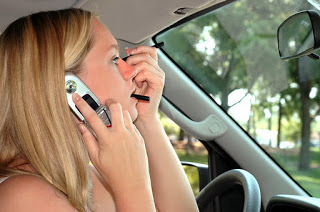Category Archive: Safe Driving

Driver Education: Traffic Safety for New High School Graduates
June 5, 2009
Summer is here and school is out. Many young drivers will be spending more time on the road going to the beach or pool, working at summer jobs, and having fun with friends. This is an especially exciting time for teens who are 2009 high school graduates. Recent grads are filled with elation, a sense of freedom, and hopes and dreams for the future. But euphoria and increased independence can cause problems when they lead relatively inexperienced drivers to take chances behind the wheel. And summertime is a dangerous time for drivers in general; traffic deaths for all drivers increase during the warm-weather months, peaking in July.
Three deadly holidays take place during the summer – Memorial Day, the Fourth of July, and Labor Day. According to the National Center for Statistics and Analysis, in a 2004 analysis of six holiday periods, the average number of traffic deaths during holiday periods was 156 per day, compared to 117 per day on non-holidays. According to the National Highway Traffic Safety Administration, 20 of the 25 deadliest days on US roads over a five-year time frame fell during the period from Memorial Day weekend to Labor Day.
Teen motor vehicle fatalities are also highest in the summer, partly because it’s an unsafe time for all drivers, but also due to risk factors specific to young drivers. Like other drivers, teens spend more time on the road during the summer (averaging 44% more hours driving each week, according to the NHTSA) and are more likely to drive at night. But they lack the experience of older drivers in dealing with heavy traffic and low-visibility conditions. Like other drivers, teens behind the wheel in the summer are often accompanied by multiple passengers. But teens are often much more distracted by their passengers than older drivers, and they are unlikely to assert themselves even when they are aware that they need to concentrate on driving.
Parents who want their teens to survive the summer must stay involved in their teens’ driving activities. Without close supervision, the vast majority of teens lack the emotional maturity to stay safe behind the wheel – or as passengers of other teen drivers.
-Though most parents will broaden driving privileges for summer, avoid giving teens too many privileges at once. Extend privileges one at a time and make sure teens prove they can handle the increased responsibility before adding more.
-Conduct supplementary driver training lessons. For example, many teens have limited experience with night driving during the school year; a few lessons will help them learn good nighttime driving habits from the beginning. A teen driving checklist helps parents provide valuable feedback on the driving lesson.
-A driver training course will help teens review fundamental driving concepts during a time when they are most at risk. A quick safe-driving refresher could help an inexperienced young driver make the right choice in an emergency. Parents whose teens receive even one traffic ticket must address the issue immediately; tickets mean teens are probably engaging in more risky driving behaviors than parents realize.
-Parents should check up on their teens’ seat belt use as often as possible. In 2006, the NHTSA reported that 58% of 16- to 20-year olds who were involved in fatal motor vehicle collisions were not wearing seat belts. The Insurance Institute for Highway Safety reports that teen seat belt use increases over time when strict parental limits are set.
-A heightened level of awareness about their teens’ access to alcohol, particularly on holidays, is critical for concerned parents. Teens may even have access to alcohol via their friends’ parents; ensure that teens understand that underage drinking is never acceptable, no matter what any other parent says or does, even for a special occasion. Create a codeword so your teen can ask to be picked up without risking the ridicule of friends.

Driver Training: Teens and Seat Belt Use
May 28, 2009
As many drivers know, teens have a higher fatality rate in motor vehicle crashes than any other age group. One reason for this is that teens have lower seat belt use rates than adults. In 2006, the National Highway Traffic Safety Administration (NHTSA) reported that 76% of drivers aged 16 to 24 used their safety belts; this figure was lower than for any other age group. Perhaps more telling, in 2006 the NHTSA also reported that 58% of 16- to 20-year olds who were involved in fatal motor vehicle collisions were not wearing seat belts.
In some states, the numbers are even worse: An observational study by the Utah Department of Health found that the teen seat belt use rate was only 67% compared to a state safety belt use rate of 88.6%. The University of Missouri reports that between 1995 and 2000, only 24% of fatally injured teen drivers were buckled up, compared to the national average of 36% for teen drivers who died in motor vehicle crashes during this time.
Why don’t teens wear safety belts? The Utah Department of Health study reported that teens offer the following reasons:
- Forgetting to buckle up
- Wanting to be cool
- Peer pressure
- Seat belts are uncomfortable
- Traveling only a short distance
- A feeling of invincibility
The same study also found that the teen seat belt use rate falls when other high-risk factors are present, such as when teens:
- Drive under the influence of alcohol
- Drive at night
- Have multiple teen passengers
- Are driving without a driver’s license
What can we do to increase the seat belt use rate among teenagers? Initiatives include:
- The University of Missouri study found that whether or not teens will use safety belts is established well before the teens begin driving. Parents who want their teens to buckle up must wear their own safety belts and use child restraints and seat belts on their children from birth. The University of Missouri study found that teens were heavily influenced by a lack of seat belt use by the adults in their lives, and the Insurance Institute for Highway Safety reports that teen seat belt use increases over time when strict parental limits are set. In an NHTSA study, about half of the unbelted students observed at 12 high schools were riding with adults who were wearing seat belts.
- Education and outreach are important methods of encouraging safety belt use. Many teens do not understand the physics of a car crash. The University of Missouri study found that teens are not well-informed about the consequences of crashes where occupants are unbelted. Teens also tend to extrapolate urban legends to a statistical majority, so they need to learn how to apply critical thinking skills to traffic safety concepts.
- Graduated Driver Licensing programs in many states have seat belt use requirements. For example, in North Carolina, graduated licensing law includes provisions for fines for up to $100 for safety belt violations by new drivers. Teens need to be educated on their state requirements and the penalties for violating them; parents need to enforce GDL laws as part of their house rules.
- Parents who are purchasing a vehicle for their teens should consider models with safety belt reminder systems.
- Schools have the opportunity to increase seat belt use by requiring student drivers and passengers to be buckled up when entering and leaving campus. Enforcement can be tied to vehicles with parking decals; penalties can be tied to restriction of and eventual loss of parking privileges.
- A primary enforcement safety belt law is effective in increasing safety belt use among teens, particularly among those who absolutely refuse to wear them otherwise. The NHTSA reports that teens are more likely to wear seat belts in states with primary enforcement laws versus in states with secondary laws. Teens often perceive indifference to safety belt use on the part of law enforcement in secondary enforcement states, because they don’t understand that enforcement is restricted by the law.
“Click It or Ticket” campaigns are also successful in increasing overall seat belt use rates.

The Importance of a Safe Driving Attitude
May 15, 2009
One important aspect of driver training is the development of a safe driving attitude. The reason a safe driving attitude is so important is because you will make many choices as you drive, and your driving choices have consequences. There are many benefits to a safe driving attitude, including:
- limiting stress while on the road
- saving you money on tickets and increased insurance costs
- helping you keep your driver license
- reducing your chances of being in a crash
To have a safe driving attitude, you must have control of your emotions and behavior, practice defensive driving techniques, and accept responsibility for all of your driving decisions.
Emotion is a word used to identify feelings such as anger, fear and joy. If you allow them to, emotions can change the way you assess risk and make driving decisions. When strong emotions such as anger affect you, your ability to make wise decisions may be reduced, increasing your chances of making a mistake. You may be so preoccupied with your anger that you misjudge the risks involved or don’t even notice important events in a particular driving situation.
Always be aware of your state of mind. Look at yourself objectively and decide if you really have the focus and alertness you need to safely use a motor vehicle. If you have any doubt, wait. Give yourself time to calm down and concentrate on safe driving. Learn more about how to avoid a road range incident.
You can expect some emotional stress in your everyday driving. Learning to manage it is important for your safety and the safety of others:
- If you are angry and excited, take a short walk, write your feelings down or talk to a friend before you get behind the wheel.
- No matter what is going on in your life, when you get behind the wheel, make a decision that until you arrive safely at your destination, you will focus on driving.
- Always allow plenty of time to get to your destination so you won’t get impatient with red lights or heavy traffic.
- Realize that many aspects of driving, such as heavy traffic and the actions of other drivers, are beyond your control. Stay calm when faced with stressful road conditions.
Part of having a safe driving attitude is consistently practicing defensive driving techniques:
- Make sure your vehicle is properly maintained
- Wear your safety belt and make sure your passengers do the same
- Choose a speed appropriate for conditions
- Make sure you have a space cushion all around your vehicle whenever possible
- Be alert and aware of the actions of all other road users, including motorcyclists, bicyclists, and pedestrians
- Watch the road ahead, behind and on both sides of your vehicle
- Anticipate problems early and select the best course of action in case the worst happens
- Give other drivers the benefit of the doubt when they make mistakes
Accepting responsibility for our decisions is an important part of becoming an adult. Willingness to do so demonstrates maturity and trustworthiness. When you drive, you must make sure you are willing to accept responsibility for all of your driving decisions. Other drivers cannot make you behave in one way or another; your reactions to their behavior are within your control. You must discipline yourself to put safety first no matter what any other driver does.
Developing a safe driving attitude is an important component of driver training; doing so from the beginning of your driving career will help keep you and others out of harm’s way on the road.

Teens and Distracted Driving
May 14, 2009
Car crashes are the number one killer of American teens, and the primary cause of fatal teen crashes is driver error. Driver distraction is included in the broad category of driver error. Though not every distracted teen driver is involved in a crash, distraction increases the risk of either causing a collision or being unable to avoid one. And though distracted driving is a problem for any driver, it is of special concern for inexperienced drivers, who may be distracted more easily and for longer periods of time and who may have difficulty controlling the vehicle even under normal conditions.
Modern diversions such as cell phones and other technical equipment are simply additions to traditional distractions such as eating, reading, dealing with passengers, reaching for objects, and looking at things or people outside of the vehicle. Dealing with passengers is one of the most frequently reported causes of distracted driving, and lively teen passengers can be particularly distracting to new drivers. Distracted driving is nothing new, but educational efforts to combat it are increasing.
It’s important to realize that when you’re driving, you’re already multitasking, because you are:
- Trying to control a large machine at high speed.
- Responding to the driving environment, including road and weather conditions, other traffic, and road signs and signals.
- Reacting to changing conditions, such as other drivers pulling out in front of you and pedestrians crossing the road ahead.
Adding another task to this list might be just enough to make you lose control of your vehicle or fail to act in time to prevent a collision.
The following tips will help prevent distracted driving:
- Increase your awareness of both physical and mental distractions. Physical distractions occur when you take your hands off the wheel and/or your eyes off the road. They happen when you adjust your stereo, take a drink of water, or reach for an object that has fallen on the floor. Mental distractions are sometimes more difficult to identify, because they don’t necessarily interfere with the physical act of driving. They occur when you argue or even laugh with a passenger, receive surprising or interesting news on your cell phone, or are preoccupied with a problem at school or work.
- Minimize the need for adjusting controls while you are driving. Take a few moments to prepare for your trip when you enter the vehicle. Adjust the seat position, climate control, stereo, and other devices before you leave your driveway or parking spot. If you are driving an unfamiliar vehicle, spend a few extra seconds locating the controls so you won’t need to look for them while you are driving.
- Review driving directions and maps, enter your destination into your navigation system and check traffic conditions before you leave. If you have a passenger, she or he can act as your navigator. Avoid sudden stop and turns while on the road by pulling over in a safe place, off the road and away from traffic, if you get confused or lost.
- Pull over to a safe place, off the road and away from traffic, to talk on the phone, text message or email. Using hands-free equipment is not safe enough because of the likelihood of mental distraction. Turn the phone off before you start out to reduce temptation.
- Stop at restaurants to eat or drink. Unwrapping food and condiment packages, reaching into bags, and having greasy fingertips are physical distractions. Realizing that you got the wrong sandwich is a mental distraction that is difficult to correct once you’ve left a drive-through window. Spilling coffee on your new shirt qualifies as both a physical and a mental distraction. Reduce your risk of a crash and your stress level by taking a few minutes to enjoy your meal outside of your vehicle.
- Keep in mind that your vehicle’s mirrors exist to help you view traffic, not yourself. Don’t use them for personal grooming while the vehicle is in motion.
As a driver, your only task when you enter your vehicle is to arrive safely at your destination. Anything else can be taken care of when you arrive. As a new driver, begin developing good habits right away by avoiding distractions and concentrating on your driving.

Four Ways Teens Benefit from Following Graduated Driver Licensing Laws
May 8, 2009
It isn’t uncommon for teens to rebel against Graduated Driver Licensing (GDL) laws. They may reason that since they passed the driving test, they shouldn’t have to deal with restrictions. Or they may be unfamiliar with the GDL laws in their state and violate them unintentionally. But there are many benefits to obeying GDL laws for teens, such as:
1. They’re a chance to prove your maturity and trustworthiness. One of the basic requirements for functioning in our society is the ability to follow the rules. Teens who are unwilling to do so demonstrate a lack of maturity and make other people, specifically adults, think they can’t be trusted. Conversely, showing that you’re willing to abide by certain restrictions lets adults, specifically your parents, know that you are grown-up and dependable enough to handle additional privileges.
2. They can help you get out of risky situations with your pride intact. You may have the best intentions of following GDL laws, but sometimes friends make that a challenge. It might be hard to resist when a friend wants you to break curfew or pile one too many passengers into your vehicle; GDL laws give you an outside authority you can blame for your refusal to do these things. You can explain that you don’t want to get caught breaking the law because you might lose your license and/or your parents might ground you from driving if you get a traffic ticket.
3. They’re the law. You won’t be lying if you tell a friend you are afraid of losing your license for breaking GDL laws; violating the terms of the law could result in the loss of your driving privileges. If you get a ticket for breaking a GDL law, you will have to pay a fine and your insurance rates, which are already high, could increase. After accruing a certain number of points on your license, you could lose it for a specified period of time and have to pay more fines to get it back. Ignorance of the law is no excuse, so be sure to familiarize yourself with the GDL laws in your state.
4. They really do keep you safe. GDL laws exist because statistically, teens get into many more crashes than adult drivers. According to the National Highway Traffic Safety Administration (NHTSA), sixteen-year old drivers have crash rates that are about three times greater than 17-year-old drivers, five times greater than 18-year-old drivers, and approximately twice the rate of 85-year-old drivers. We know that GDL laws work, because there has been an overall decrease in fatal crashes involving teens nationally since GDL laws began to be implemented. Specific restrictions have also been found to be effective; for example, an NHTSA study found that states with nighttime driving restrictions for teen drivers show decreases in crashes of up to 60% during the restricted hours. GDL laws work because they help teens increase their driving skills while minimizing the risks of being on the road with limited experience.
You can probably see how these four factors tie together. If you break GDL laws, you show the adults in your life that you can’t be trusted, you are more likely to be peer-pressured into taking risks you know you shouldn’t take, you take a chance on losing your license, and you raise the possibility that you or someone riding with you will be injured or killed in a crash. When you choose to follow GDL laws, you have nothing to lose and everything to gain.
